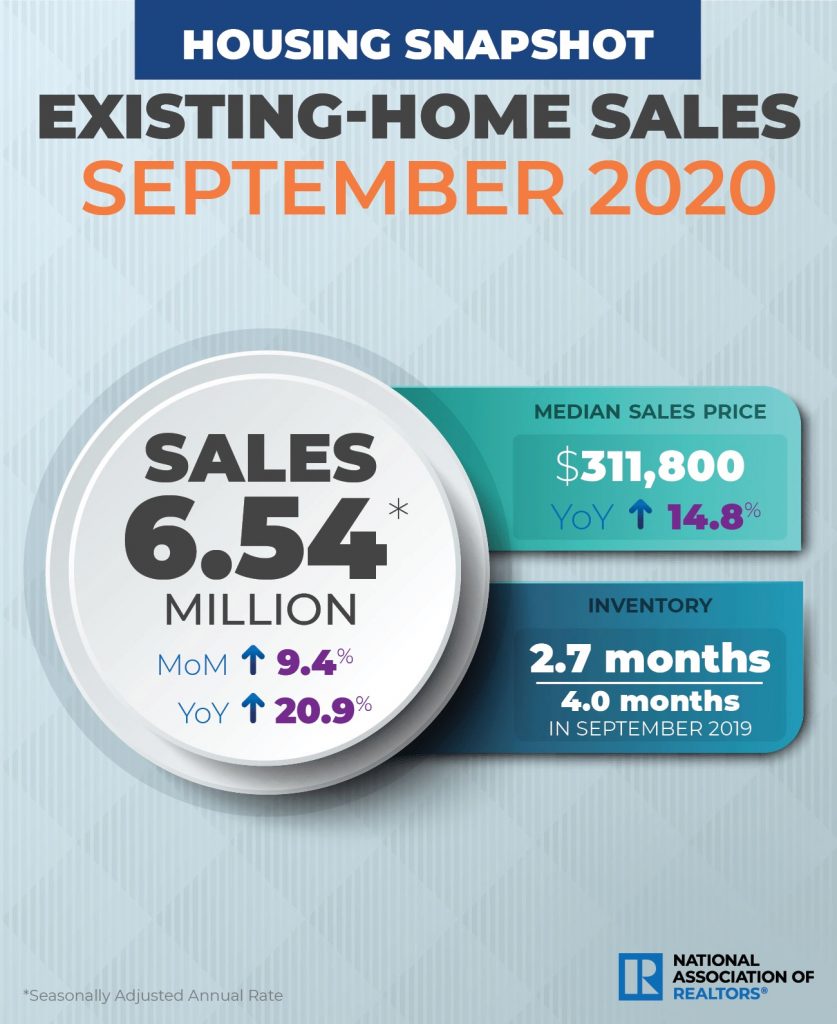September marked the fourth consecutive month of existing-home sales growth, according to the National Association of REALTORS® (NAR). Overall, existing-home sales transactions increased 9.4 percent from August to a seasonally-adjusted rate of 6.54 million in September. This is a 20.9 percent increase from the same time last year.
Single-family home sales increased 9.7 percent in September to 5.85 million—that’s up 21.8 percent YoY. For condos and co-ops, existing sales increased 6.3 percent from August to 670,000 units, and are up 13.6 percent YoY.

By Region:
Midwest
Existing-Home Sales: 1.5 million (+19.8%YoY)
Median Price: $243,100 (+14.8%YoY)
Northeast
Existing-Home Sales: 860,000 (+22.9% YoY)
Median Price: $354,600 (+17.8% YoY)
South
Existing-Home Sales: 2.80 million (+22.3% YoY)
Median Price: $266,900 (+13.0% YoY)
West
Existing-Home Sales: 1.37 million (+18.1% YoY)
Median Price: $470,800 (+17.1%YoY)
How the Industry Is Responding:
“Home sales traditionally taper off toward the end of the year, but in September they surged beyond what we normally see during this season. I would attribute this jump to record-low interest rates and an abundance of buyers in the marketplace, including buyers of vacation homes given the greater flexibility to work from home. There is no shortage of hopeful, potential buyers, but inventory is historically low. To their credit, we have seen some homebuilders move to ramp up supply, but a need for even more production still exists. The uncertainty about when the pandemic will end coupled with the ability to work from home appears to have boosted sales in summer resort regions, including Lake Tahoe, mid-Atlantic beaches (Rehoboth Beach, Myrtle Beach) and the Jersey shore areas.” — NAR Chief Economist Lawrence Yun
“Home sales flourished this past month, even as we contend with an ongoing and unforgiving pandemic. I couldn’t be prouder of all the brokerages and REALTORS® who have helped us navigate these challenging times to ensure our nation’s economy continues moving forward.” — NAR President Vince Malta
“Existing-home sales jumped in September, rising to their fastest pace since before the financial crisis, and up more than 20 percent compared to last year. Contributing to this surge in sales activity is an improving job market, low rates and families across the country looking for more— or different—space. The primary constraint to even more sales is the plummeting inventory of homes on the market, which is leading to bidding wars and spikes in home prices across the country. Fortunately, we are seeing a pick up in the pace of construction, which should bring more inventory onto the market for next year’s buyers. This positive report aligns with MBA’s 2021 forecast for a record year of purchase originations.
“Typical seasonal patterns for home sales have likely been thrown off as a result of this crisis. Sales that would have normally occurred in the summer have likely been pushed into the fall, and this may account for some of the extremely fast pace of existing sales on a seasonally adjusted basis.” — Mortgage Bankers Association SVP and Chief Economist Mike Fratantoni
“Existing-home sales seem poised to continue to increase for the rest of 2020, but near-record-low inventory levels may start to have a dampening effect on sales. Mortgage rates are continuing to drive demand and are going to remain near record lows the rest of the year, and likely well into 2021. Accelerating price increases are potentially going to start to reverse some of the benefits we are seeing from low mortgage rates, and this could start to slow demand from entry-level buyers as their purchasing power diminishes. The housing market remains a source of growth in the economy, largely as a result of the disparate impact of the pandemic across employment sectors.
“Higher earners have been more likely to retain their incomes, allowing the housing market to continue booming despite extremely high unemployment levels. Without a broader recovery, there remains risk to the housing market. As long as unemployment remains elevated, there is a possibility that we see layoffs spill into the higher-paying sectors that are currently propping up the housing market. That broader recovery will likely hinge on medical progress toward ending the pandemic, as well as a strong fiscal stimulus that helps families maintain their incomes while the economy remains at reduced capacity.” — Keller Williams Chief Economist Ruben Gonzalez
For more information, please visit www.nar.realtor.












